Summarize this blog post with:
The world of SEO is constantly evolving. So, how do you ensure that your SEO strategy is not just surviving, but also thriving in 2025?
With search engine algorithms becoming more sophisticated and AI-driven, it’s crucial to track the right SEO metrics that align with your business goals. However, without a clear focus, you risk wasting time on data that doesn’t move the needle.
In this blog, we’ll explore the 11 most important SEO metrics to track for better rankings, visibility and ROI. Besides, we’ll also show you a dedicated SEO metrics mastery plan to maximize goals and streamline your SEO performance.
Let’s get started.
Why is tracking the right SEO metrics important?
The global SEO market is estimated to reach $143.9 billion by 2030. To thrive in this competitive digital marketing landscape, focusing on the right SEO metrics is essential for sustainable growth and measurable success. Here’s why it's important:
- Focus on what matters: Align your SEO metrics with (client) business goals to ensure your efforts are capturing the right intent.
- Stay ahead of algorithm changes: Tracking relevant metrics helps you adapt and stay strong in the dynamic environment.
- Improve conversions: Monitor user engagement metrics like bounce rate and average engagement time to optimize your page layout and content for higher conversion rates.
- Spot growth opportunities: Whether it is optimizing page load times or refining content strategy, the right SEO metrics help you accelerate your approach for better outcomes.
- Measure ROI: With consistent, automated SEO reporting, you can ensure your efforts are delivering value and adjust strategies that aren’t working.
Overall, focusing on the right metrics keeps you agile and helps you to make data-driven decisions that maximize your client’s SEO goals and performance.
10 Most Important SEO Metrics to Track
In this section, we’ll explore the top 10 SEO metrics that are key to optimizing your SEO strategy for maximum performance.
1. Total clicks
Total clicks refers to the number of times users click on your website’s link in Google or other search engines. The higher the clicks, the better your content resonates with the relevant audience.
Why it matters:
Total clicks indicate how well your web pages are gaining attention in the SERPs. You can relatively assess the overall intent, positioning, messaging, and structure of your content to users based on how often it is clicked.
How to improve:
- Write clear and engaging meta titles and descriptions that are relevant to your user intent.
- Use high-intent keywords to target users who are most likely to click and convert.
- Employ schema markup (structured data) to enhance rich snippets, which can increase your click-through rates.
2. Core Web Vitals
Core Web Vitals lets you measure your website’s user experience. You can track the following key metrics: page load performance (Largest Contentful Paint), interactivity (First Input Delay), and visual stability (Cumulative Layout Shift).
Why it matters:
A fast-loading website is crucial for delivering a friction-free user experience. Even if your site ranks well for targeted keywords, it doesn’t make sense if it fails to keep users engaged for a long time. This is where Core Web Vitals play a major role in improving your website’s accessibility, speed and performance, leading to higher conversion rates.
How to improve:
- Minimize FID by optimizing scripts that impact interactivity.
- Run regular website audits to ensure your website’s technical SEO performance is consistently optimized.
- Ensure your website images follow standard size and streamline the user’s navigation flow.
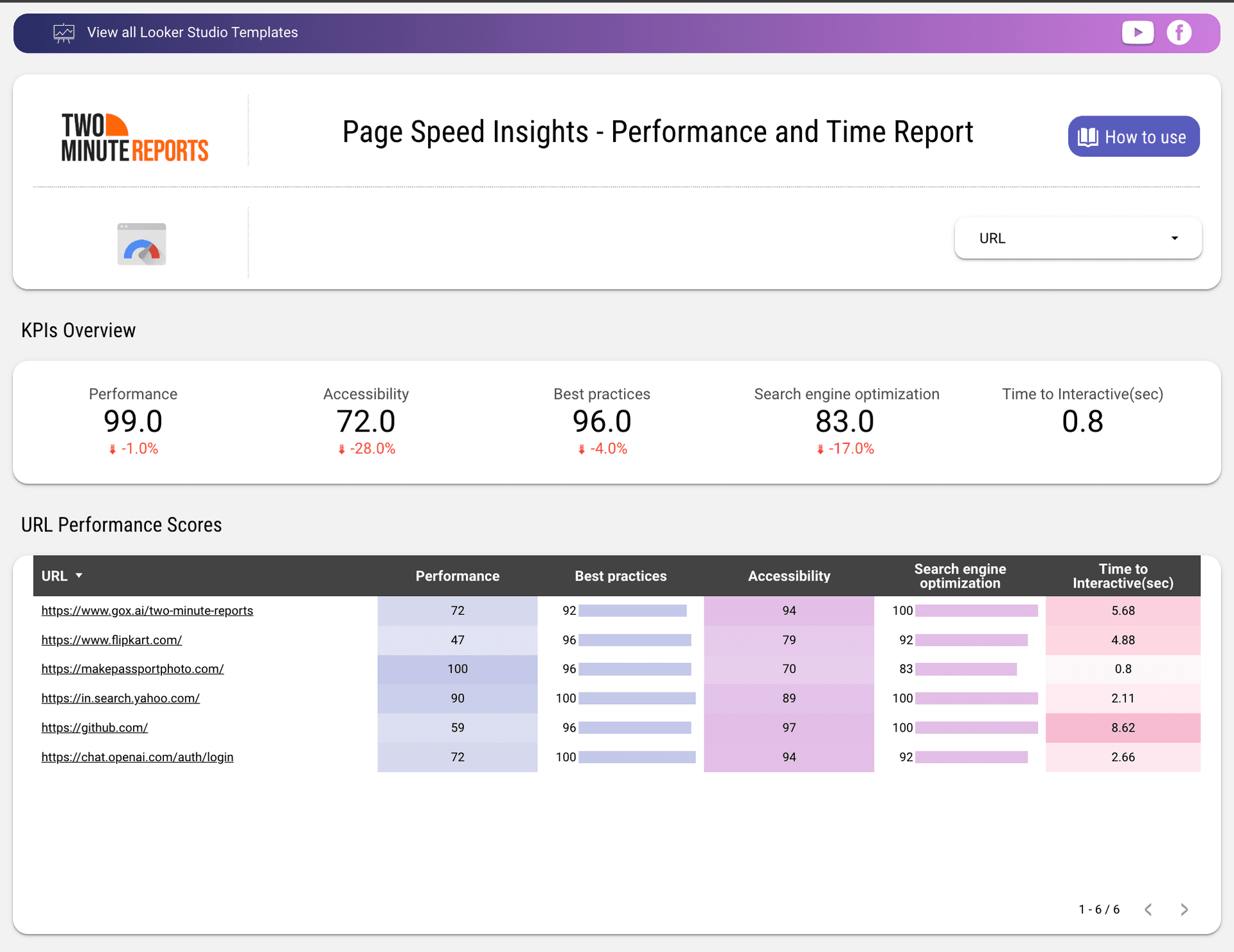
Use our free Page Speed Insights template to consistently track and optimize your website for faster load times and improved user experience.
3. Organic traffic
Organic traffic is a valuable indicator of your website’s SEO health. It refers to the number of visitors who land on your website through unpaid search results, meaning they clicked on your link after searching for a relevant keyword.
Why it matters:
Organic traffic is considered the SEO north star. It indicates that your content is ranking well for relevant search queries, such that the site visitors are often more engaged with your product or service and are likely to convert.
How to improve:
- Optimize for long-tail keywords: Target specific, competitive keywords that match user intent and drive more qualified traffic.
- Create high-quality, relevant content: Focus on answering users’ queries with in-depth, valuable content that solves problems.
- Improve on-page SEO: Optimize title tags, descriptions, image alt, and headings to ensure your content is fully optimized for search engines.
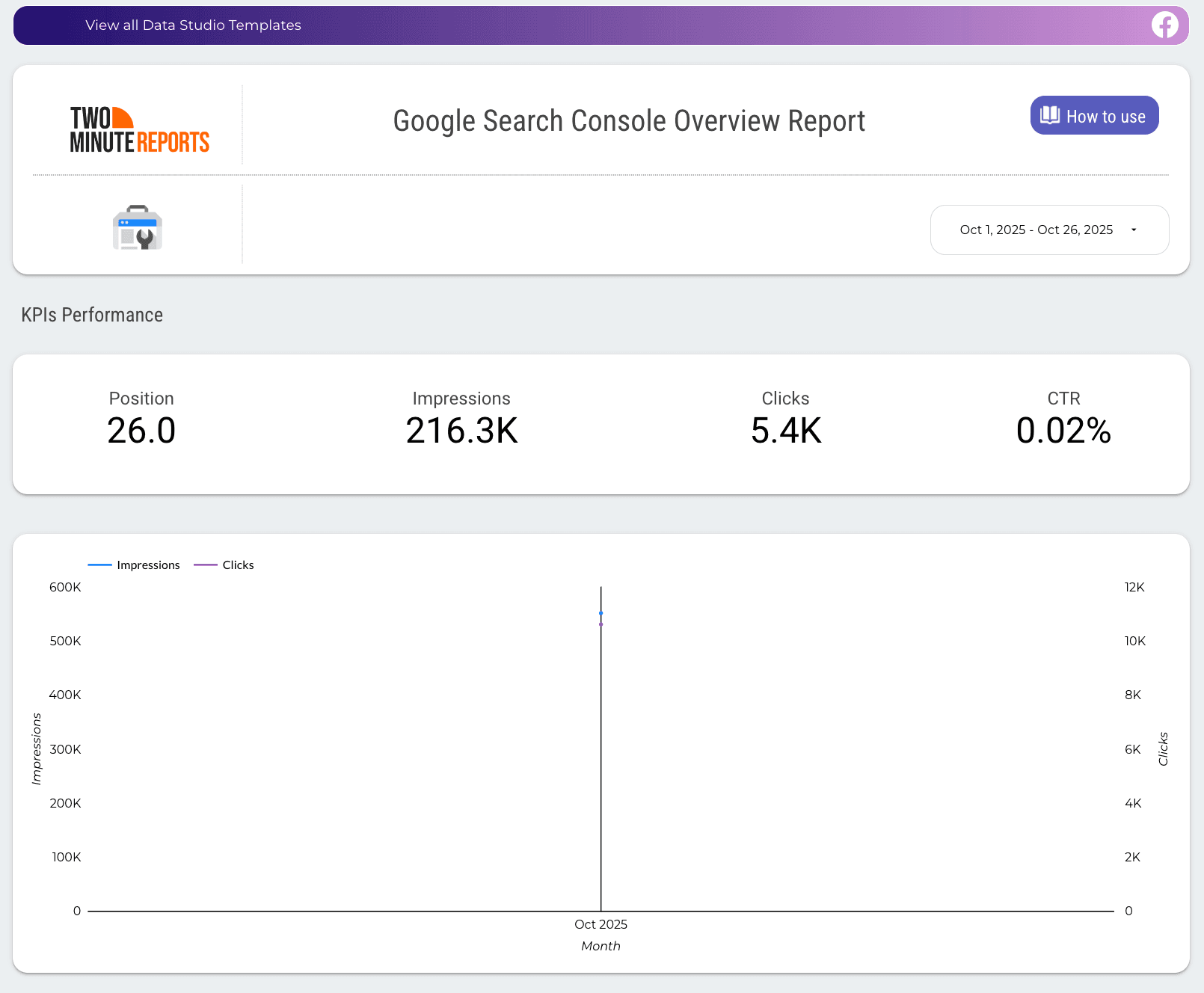
Use our free Google Search Console Reporting template to track impressions, clicks, CTR, and position. Analyze your SEO strategy's effectiveness and make targeted improvements to maximize visibility.
4. Keyword rankings
With the ever-changing AI overviews and rise in zero-click searches, do you still track keyword rankings? Yes, it does matter. Keyword rankings refer to the position your website holds on SERPs for specific keywords or search terms. This key SEO metric is a crucial driver in conceptualizing and strengthening your overall SEO content strategy.
Why it matters: Higher keyword rankings mean your content is being recognized by search engines, which increases visibility and drives targeted traffic. Tracking keyword rankings helps you understand which topics are resonating with your audience and which need further optimization.
How to improve:
- Focus on user intent: Ensure your content matches the search intent behind your target keywords.
- Optimize content for featured snippets: Target question-based queries and structure your content to appear in these high-visibility spots.
- Build high-quality backlinks: Strengthening your domain authority through backlinks can help improve keyword rankings over time.
Pro tip: Find high-converting queries and fix low-ranking pages in 3 simple steps with our Google Search Console Reporting tool.
- Connect your Google Search Console account to Google Sheets or Looker Studio.
- Select key metrics to track. Choose hourly or weekly refresh syncs.
- Create actionable GSC reports and reuse across multiple clients.
5. Backlinks
A backlink, also called an inbound link, is created when someone links from their website to yours. They act as endorsements, signalling to search engines that your content is trustworthy and authoritative.
Why it matters: Backlinks are a major ranking factor for search engines. The more high-quality backlinks your site has, the higher it can rank in search results. They also drive referral traffic, boosting visibility and credibility.
How to improve:
- Create shareable, authentic content: Content that provides value is more likely to be shared and linked by others. Examples include infographics, statistics, etc.
- Guest blogging and partnerships: Collaborate with reputable sites for guest posts and backlink opportunities.
- Monitor link profile: Regularly check your backlink profile and remove any low-quality or spammy links that could hurt your rankings.
Backlinks are one of the strongest signals search engines use to assess your site’s authority. Building a healthy backlink profile will improve your SEO performance and drive more organic traffic.
6. Organic CTR
Organic CTR is the percentage of users who click on your website link in the search results, divided by the number of impressions. If your organic CTR is low, ask yourself the following questions:
- Is your content answering the user’s query?
- Are your page URLs relevant to the content?
- Is your content mobile-friendly?
- Are you targeting the right audience with your keywords?
- How does your listing compare to competitors in the SERPs?
Why it matters: A higher organic CTR indicates that your titles, meta descriptions, and overall content are compelling and relevant to users’ search queries. It directly impacts your ability to drive traffic from search engines and can influence your rankings.
How to improve:
- Create engaging and click-worthy (not clickbait) titles and descriptions to capture users’ attention.
- Use schema markup to make your listings stand out in rich snippets.
- Highlight what makes your content unique from the rest of the competition.
- Test different variations of title tags and descriptions to find which version resonates the best with your audience.
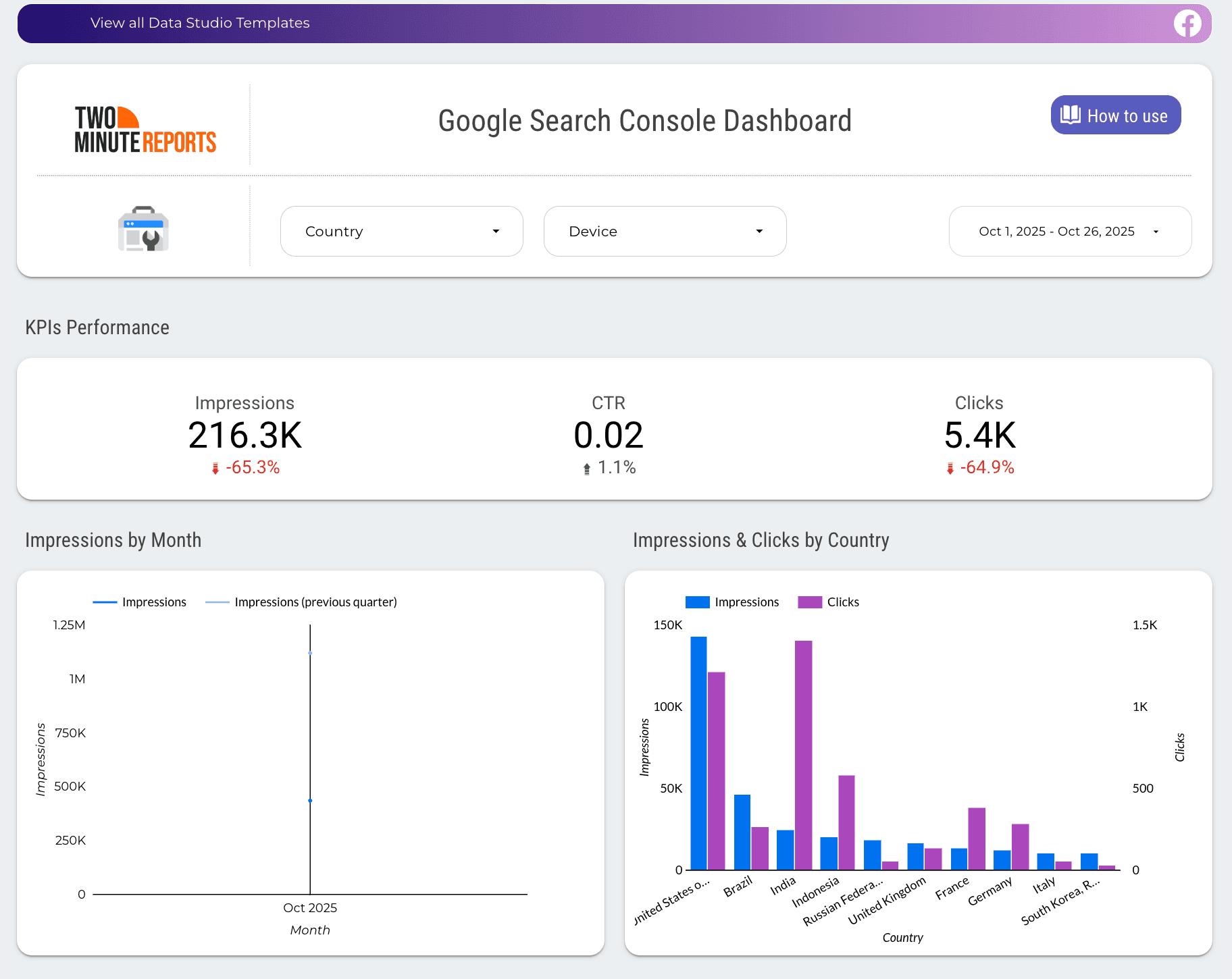
Optimize your website’s core performance with this Google Search Console template. Compare impressions, CTR, and clicks based on queries and pages to maximize audience intent and improve rankings.
7. Conversion rate
Conversion rate is the percentage of users who complete a desired action on your website. This key SEO metric is a direct reflection of organic traffic. The higher the quality of your traffic, the more conversions you’ll get.
Why it matters: It’s a crucial indicator of how well your site turns visitors into customers or leads. A high conversion rate means your content, design, and user experience are aligned with your audience's needs.
How to improve:
- Optimize landing pages: Ensure they’re relevant, visually appealing, and aligned with user intent.
- Improve Call-to-Actions: Make them clear, compelling and easy to act.
- Test user flow: Simplify the conversion process by reducing unnecessary steps and eliminating distractions.
8. Referring domains
Referring domains are the unique websites that link back to your website. Unlike backlinks, which count every individual link, referring domains count only the number of distinct websites that provide links.
Why it matters: A diverse set of referring domains indicates a strong backlink profile and enhances your site’s authority. More referring domains can improve your search rankings and drive more referral traffic.
How to improve:
- Build relationships: Network with industry experts and bloggers to earn quality backlinks.
- Guest post on reputable sites: Contribute content to authoritative websites in your niche to gain backlinks.
- Create shareable content: High-quality, informative content is more likely to be linked to from various sources.
Referring domains play a crucial role in SEO by boosting domain authority and increasing referral traffic. Focus on building a strong, diverse backlink profile for better rankings and visibility.
9. Domain authority
Domain Authority (DA) is a score (from 0 to 100) that measures the overall strength and credibility of your website in the eyes of search engines. It is influenced by factors like the number and quality of backlinks, referring domains, and overall content quality.
Why it matters: A higher DA score signals to search engines that your site is authoritative and trustworthy, which can help you rank higher in search results. It’s directly impacted by the quality and quantity of referring domains.
How to improve:
- Acquire high-quality backlinks: Focus on gaining backlinks from reputable, high-authority websites.
- Increase referring domains: As you build a diverse set of referring domains, your DA will improve, strengthening your site’s credibility.
- Perform regular audit: Identify and remove spammy links that can affect your DA score.
10. Search impressions
Search impressions refer to the number of times your business profile appears in Google search results or maps, regardless of whether users click on it. This data can be accessed through your Google Business Profile insights.
Why it matters: Impressions indicate how often your business is visible to potential customers. A higher number of impressions means your business is being shown to more people, which can increase brand awareness and lead to more clicks and conversions.
How to improve:
- Optimize your profile: Ensure your Google Business Profile is complete, accurate, and regularly updated with your business hours, services, and photos.
- Encourage reviews: Positive reviews can improve visibility in local searches and drive more impressions.
- Use relevant keywords: Include location-specific and industry-relevant keywords in your profile description to reach the right audience.
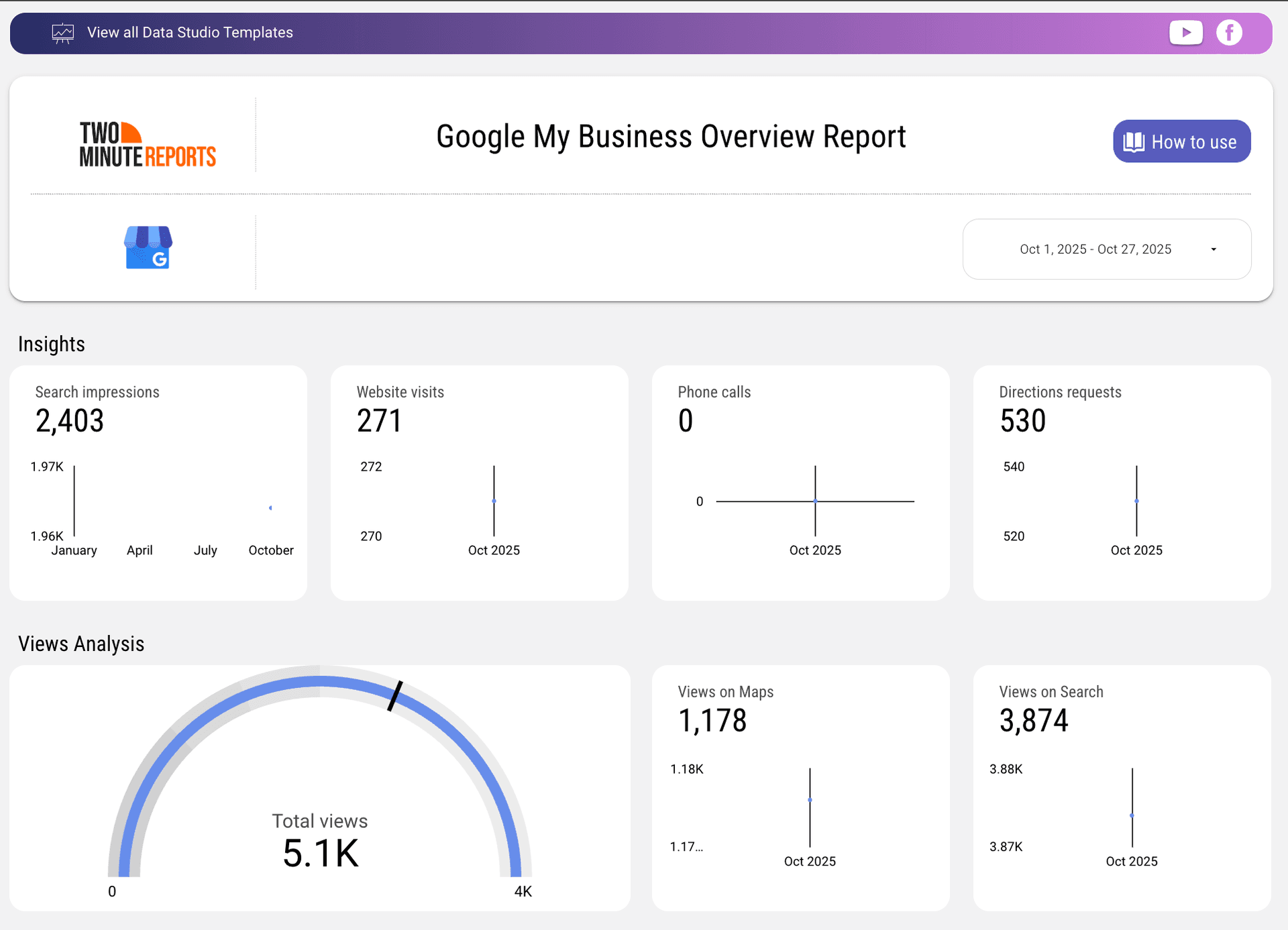
Optimize your GMB profile performance in real-time with our customizable Google My Business template. Track key metrics such as search impressions, website visits, views on maps vs search, total views over time and top search terms based on the location in a single dashboard.
Your SEO Metrics Mastery Plan
You’ve learned about the most important SEO metrics to track. Now it's time to translate those insights into action. This will help you better track performance, streamline SEO reporting and optimize for organic conversions.
Useful tips to level up your SEO metrics game
1. Segment your data for clarity
Classify metrics by device, location, and landing page. This helps uncover patterns you might miss in the aggregate data – like mobile users bouncing faster or specific pages underperforming due to wrong intent.
2. Monitor trends over time
SEO metrics fluctuate daily. Look at the trends across weeks or months to make informed decisions rather than reacting to short-term spikes.
3. Correlate metrics for deeper insights
Measuring metrics in isolation leads to fragmented insights. Instead, combine CTR with keyword ranking or conversion rate to understand the full picture behind the performance shifts.
4. Set clear goals for each page type
Define success metrics for blogs, product pages, and landing pages. For instance, blogs may focus on traffic and time on page, while landing pages primarily focus on conversions.
5. Keep an eye on lagging metrics
Some key SEO metrics (like backlinks or keyword rankings) take time to reflect SEO efforts. Track them consistently, but focus on leading indicators like CTR and engagement.
Pro tip: Take your SEO reporting to the next level with these proven tracking methods:
- Track new vs returning visitors to understand if your SEO is attracting fresh audiences or building loyalty.
- Compare average position vs CTR to find and fix low-ranking pages on SERP.
- Analyze content updates vs ranking changes over time to identify what kind of content actually drives the audience to your website.
- Compare landing pages vs keywords to check if your pages actually match the search intent. This is the easiest way to spot content gaps.
How to visualize SEO metrics?
Level up your SEO metric visualization with these actionable tips:
- Use sparklines in your report. These compact charts show trends over time, giving you a snapshot of progress or decline next to current performance metrics.
- Leverage bar charts to compare keyword performance across multiple pages, quickly identifying which content is driving more traffic.
- Implement pie charts for backlinks, showing the share of backlinks from various sources to assess the overall strength of your backlink profile.
- Track keyword rankings with line graphs. These show how your rankings for specific keywords change over time, helping you evaluate the impact of your SEO efforts.
Track all your key SEO metrics holistically with Two Minute Reports
Manually wrangling SEO metrics from multiple sources can be a strenuous task. This is where an SEO reporting software, such as Two Minute Reports, helps you centralize key SEO metrics, streamline performance, and automate reports in real-time to stay ahead of the optimization game.
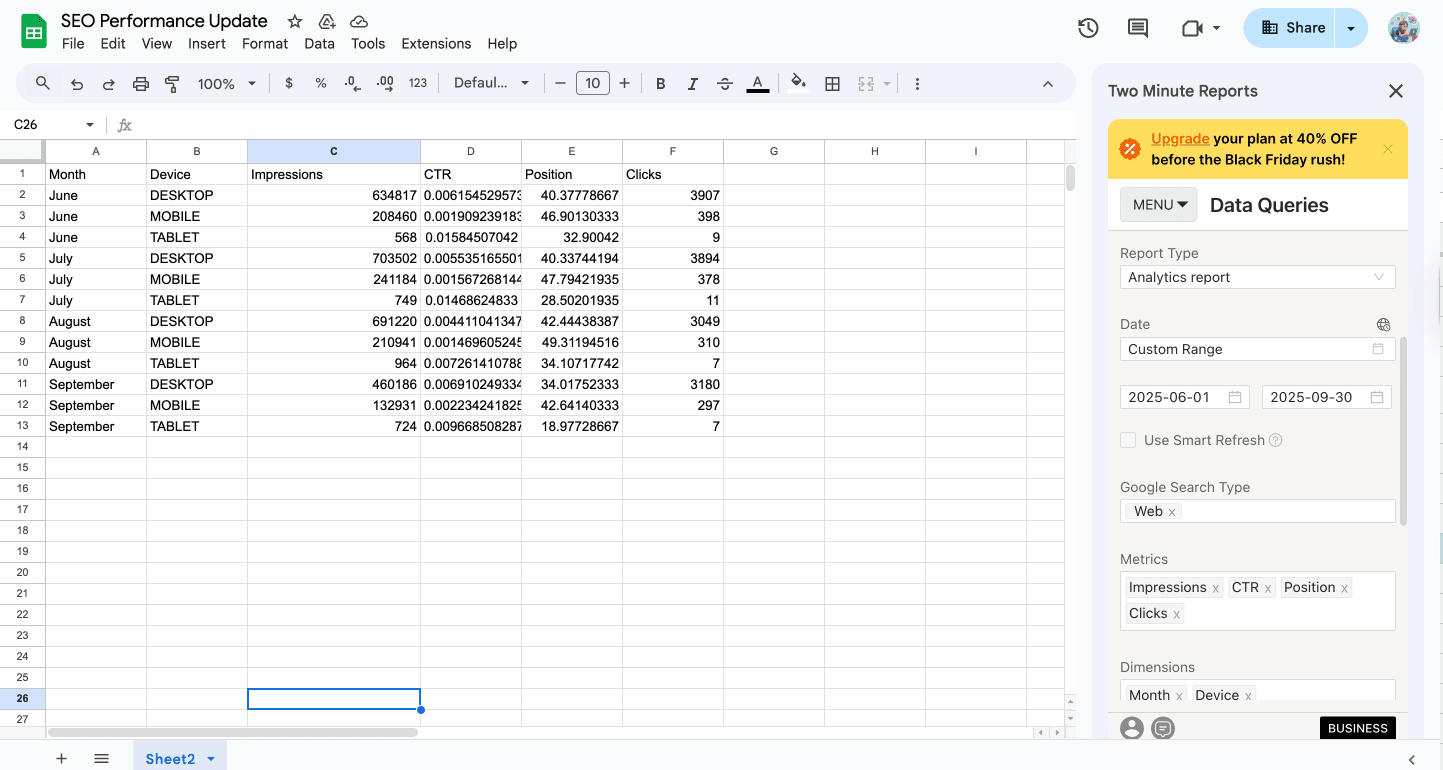 A snapshot of tracking SEO metrics
A snapshot of tracking SEO metrics Here’s how Two Minute Reports eases your SEO metrics tracking and reporting:
- Connect your SEO tools – GSC, GA4, GMB, Page Speed Insights and Google Trends via no-code setup in minutes.
- Extract key metrics from your preferred tool and build custom SEO dashboards to track performance and progress.
- Set up an automated refresh schedule (daily, weekly or monthly) to regularly update your clients on real-time SEO enhancements.
- Deliver branded SEO reports to demonstrate your agency’s professionalism and expertise to your stakeholders.
Wrapping up
As SEO is constantly evolving, it's crucial to understand what drives organic conversions and ROI for your business. By focusing on the right metrics and visualizing them clearly, you can create a scalable framework to stand ahead in the Google SEO battle.
Here are the key takeaways:
- Track all key SEO metrics in one place for easy access and analysis.
- Regularly monitor Organic Traffic, Keyword Rankings, Conversion Rate and Core Web Vitals for deep insights into performance.
- Quickly identify underperforming pages and refine your SEO strategy accordingly.
- Automate SEO reports in real-time using Two Minute Reports and stay ahead of the competition.
Frequently Asked Questions
To improve SEO performance, focus on the key metrics such as organic traffic, keyword rankings, and conversion rates. Using Two Minute Reports, you can automate tracking of these metrics, gain real-time insights, and make data-driven adjustments to your strategy without wasting time on manual data collection.
To improve bounce rate, focus on optimizing page load speed, refining content relevance, and implementing an action-driven CTA. Analyzing metrics like session duration and CTR can provide deeper insights into user behavior, helping you create a more engaging experience that keeps visitors on your website longer.
You can measure the effectiveness of your SEO strategy by tracking keyword rankings, organic traffic, CTR, and conversion rates. If these metrics are improving, your strategy is in good shape. With a reliable SEO reporting software, you can monitor these KPIs in real time, ensuring your SEO efforts are always aligned with your goals.
To save time on SEO reporting, automate your metrics tracking with Two Minute Reports. Set up custom refresh schedules (daily, weekly or monthly) to track organic traffic, backlink profiles, keyword ranking, conversions, etc, so you can focus on optimizing your strategy and not juggling spreadsheets.
You can install the Two Minute Reports add-on from the Google Workspace Marketplace. Once done, you can connect your SEO tools, extract KPIs, build custom dashboards, and automate performance reports to stay aligned with your client’s goals.
Related Blogs

Meet the Author
Shalini MuruganShalini is driven by ideas that create a tangible impact. At Two Minute Reports, she specializes in content that helps marketers optimize their reporting workflows. When she's not transforming complex data into meaningful insights, you might find her lost in a book, jotting down ideas in her notebook, or connecting the dots others overlook.





